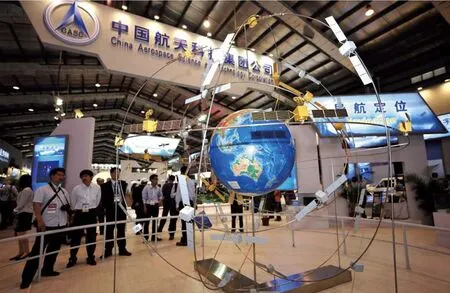Beidou Shines Into Daily Life
By TANG YUANKAI
Beidou Shines Into Daily Life
By TANG YUANKAI

SUCCESSFUL LAUNCH: A Long March 3 rocket carries the eighth Beidou satellite into orbit from the Xichang Satellite Launch Center on April 10
China’s Beidou navigation system is used more frequently in emergencies
China’s regional satellite navigation network has been basically completed. It was marked by the successful launch of the eighthBeidou(Compass) satellite into orbit carried by a Long March 3 rocket on April 10.
“As signi fi cant infrastructure, the Beidou navigation system has special meaning for China’s national security and economic construction. It also plays an important role in common people’s daily lives,” said academician Yang Yuanxi, one of the three executive chairmen of the 2011 China Satellite Navigation Conference (CSNC). “From next year, China’s private car owners will also be able to use the positioning function of theBeidousatellites.”
When all regional satellites have been launched, the Beidou system will play a role in people’s daily life, said Li Changjiang,chief commander of the system.
Effective function
During the past few decades, Chinese scientists have been devoted to developing the country’s own satellite navigation system.
Most people knew about Beidou system after the 8.0-magnitude earthquake struck Wenchuan County in southwest China’s Sichuan Province on May 12, 2008. All communications infrastructure there was destroyed, isolating the area totally from the outside world. About 10 p.m. that day, the first rescue team arrived in the earthquakestricken areas. Using civilian-level Beidou 1 System terminal devices, rescuers soon transmitted information about the emergency and aid requirements to the outside world.From then on, real-time information about the disaster was sent continuously to relief headquarters accurately and swiftly.
Before any communications system was fully restored in the affected area, rescue forces were equipped with more than 1,000 Beidou 1 System terminal devices, which helped rescuers realize direct links between rescue points and headquarters. Shortly after rescue forces with this equipment arrived in Wenchuan, the control center for the navigation and positioning system in Beijing had pinpointed their locations.
The Beidou has an innovative function—two-way text messaging, which can’t be realized by the U.S. Global Positioning System (GPS) and Russia’s Global Navigation Satellite System (GLONASS).Users of the Beidou system can send up to 120 characters at a time. It is exceptionally useful especially in remote areas, in deserts or on seas where mobile phone services are unavailable.
During the Wenchuan rescue, with the help of this function of the Beidou 1 System,rescuers were able to communicate with theirheadquarters directly through text messages and the function has become vital in many successful rescues.

ON SHOW:The model of the Beidou Satellite Navigation System is displayed at the Eighth China International Aviation and Aerospace Exhibition in Zhuhai, Guangdong Province, in November 2010
Different from GPS positioning, the Beidou system enables two-way positioning.It not only allows users to know where they are, but also allows others to know the locations of the users. This function will prove useful for rescues in disaster areas.
Timing is another important function of the Beidou system. Precise timing has wide and vital applications in many areas, including public transportation, communications,electric power and national defense.
The Beidou system provides both oneand two-way timing. The one-way timing is precise to 50 nanoseconds, while the twoway is 10 nanoseconds, the world’s most precise rate at present.
Daily application
Today, the Beidou 1 System is widely used in various fi elds, such as mapping, telecommunication, water conservancy, fi shery,transportation, disaster relief and national security.
Many fishery departments have begun to use the Beidou system. GPS can only tell the longitude and latitude of a certain spot but when it comes to emergencies at sea, knowing the longitude and latitude is far from enough as the spot is surrounded by sea.
Using the Beidou system, a button has only to be pressed and an alarm in a fi shery management department will be triggered,transmitting speed, direction and precise longitude and latitude of the trapped ship to a rescue team within a second, so rescue work can be started as soon as possible. Also, staff on a ship can receive a text message from the Beidou system control center about the location of the nearest ship, information about how long the rescue will take and helpful advice from professionals.
“If there is a typhoon, fishery management departments will inform Beidou system-equipped ships as soon as possible,”said Zhao Kangning, Deputy Director of the China Satellite Navigation Positioning Application Management Center.
The application of the Beidou system in people’s daily life is partly attributed to government support. With preferential policies and subsidies, Beidou terminals have been applied along China’s 18,000-km coast.Market models have also been constructed.
“The precise positioning of the Beidou system can also be used for land and farmland management, which allows precise cultivation of farmland conducted by agricultural machinery,” said academician Liu Jingnan, another executive chairman of 2011 CSNC. “Also, it can monitor tiny changes in large-scale projects, such as the construction of bridges and dams.”
“After the completion of the Beidou global system, civil applications will account for 95 percent of the total applications,” said academician Sun Jiadong, chief designer of the Beidou Satellite Navigation System Project.
“China has put great emphasis on developing and promoting user terminals of the Beidou system. Many domestic manufacturers are now making efforts to develop portable and convenient user terminal equipment,” said Li.
Global use
The building of the Beidou system has been divided into three steps. The goals of the first step have already been achieved.From 2000-03, China launched threeBeidousatellites and built an experimental navigation system, becoming the third country in the world to develop a satellite navigation system after the United States and Russia.The second step is to build a network of satellites. More than 10 satellites will be launched into three orbits by 2012, which will provide services such as navigation,positioning and timing for the Asia-Pacific region. The third step aims to build a global satellite navigation system by around 2020 with fi ve geostationary orbit satellites and 30 non-geostationary orbit satellites, to provide passive global location services.
As an important part of the Global Navigation Satellite System—which consists of GPS from the United States, GLONASS from Russia, Galileo from Europe and Beidou from China—the Beidou system also monitors global tectonic plate movements,which is the most important way to predict earthquakes.
“The Beidou system is not only the Chinese people’s Beidou but the world’s Beidou. It is making a contribution to the world,” said academician Yang. “Beidou has helped add greater precision, stability and reliability to the global navigation system.”
“In an attempt for greater global application, the Beidou system is also making efforts to improve its compatibility,” said Xie Jun,chief designer of the satellite system of the Beidou system. “Great compatibility will give Beidou users many advantages as they will be able to receive information from different kinds of navigation satellites with higher precision. Another bene fi t of higher compatibility is the full use of space resources.”

